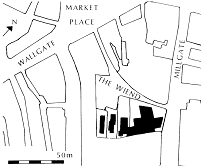|
I don’t know if you have noticed, but a large swathe of the countryside has been
laid open just north of Wigan. This is in preparation for the Transco gas pipeline
running from Mawdsley to Warrington. It is taking a very circuitous route around
Standish, Adlington, Westhoughton, Atherton, Leigh and onto Glazebury and Culcheth.
It should provide a great opportunity for archaeological discovery, as it crosses two
Roman roads. Environmental Archaeological Services are carrying out the evaluations
and both Lancashire and Greater Manchester Archaeology are keeping a close eye on
developments.
CBA Northwest
This year’s AGM will be held at the Norton Priory Museum in Runcorn on Saturday,
6th May. The proceedings will include the usual series of reports on recent work
from around the region. People who are interested should contact me as soon as possible.
Geophys
The resistivity meter frame is now complete and last week I surveyed my back lawn to
see if I could spot the trench I dug a few years ago. That didn’t appear, but
more worryingly, a large anomaly in the middle did. Next weekend John Barker and
myself have arranged to speak to the farmer at Brimlow. His two fields should be a
good test for the meter and also hopefully tell us more about the direction of the Roman
road.
Next Meeting
Wednesday 3rd May at the BP Centre (Scout HQ) in Greenough Street, at 7.30 pm as
usual.This month’s speaker is Adrian Tindall from Chester Archaeology. In the
early 80’s Adrian worked for the Greater Manchester Archaeology Unit who were very
active in the Wigan area at that time. In fact it was Adrian who supervised the
excavations in the Wiend. This work is still regarded as the most comprehensive
study ever done in the Wigan district. Funded by the Manpower Services Commission it
was the first time the remains of Roman Wigan had been revealed and recorded
in-situ. Here are the details.

Roman Wigan
|
The work centred on the area now occupied by the new children’s library at
the top of Mill Gate and uncovered four phases of Roman settlement spanning the late 1st
to 2nd century AD.
The early phases were associated with cobbled surfaces and substantial timber storage
buildings of a seemingly temporary nature. The deliberate destruction of these
building together with the pottery assemblage strongly suggests military activity.
This was particularly apparent in the 2nd phase when large sleeper-beams were used to
support floor with less substantial joists. The later phases were associated with heavy
industrial activity, particularly in the 4th phase when large hearths with flat stone
bases were uncovered.
These were tentatively identified as bloomery furnaces. The large quantities of
iron slag, cannel coal and wood or charcoal, strongly suggest some form of large-scale
iron working activity.
Medieval Well
The excavations also revealed the earliest medieval feature ever found in Wigan.
This was a square timber-lined well or cistern dating from the 13th century.
The pottery retrieved from its base represent the only artefacts ever found in the area
from this period, which is remarkable considering Wigan’s historical heritage.
The pieces, 3 virtually complete earthenware vessels, are on display in the History Shop.
A deed dating form before 1293 refers to “La Hally Well Kar” (or Holly Well
Field) “between the land of Nicholas de Tildesleye and the water of Dogles”. It
would be nice to think that this well was the one referred to in the deed.
(Information from The Greater Manchester Archaeological Journal 1985)
At the meeting, Adrian will also be updating us on the more significant Roman work
recently carried out around Chester.
Hope to see you at the meeting - B.A. |



